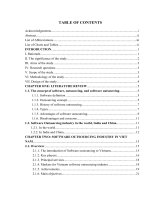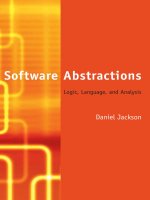Software EngineeringIntroduction & Software Requirements Analysis &Specifications
Bạn đang xem bản rút gọn của tài liệu. Xem và tải ngay bản đầy đủ của tài liệu tại đây (1.2 MB, 200 trang )
Software Engineering
Introduction
&
Software Requirements Analysis &
Specifications
UNIT I
© Bharati Vidyapeeth’s Institute of Computer Applications and Management, New Delhi-63, by Nitish Pathak
U1. 1
Introduction to Software
Engineering
© Bharati Vidyapeeth’s Institute of Computer Applications and Management, New Delhi-63, by Nitish Pathak
U1. 2
Learning Objectives
• What is Software
• Documents
• Software vs. Hardware Characteristics
• Types of Software
• Good Software
• Need for Software Engineering
• Software Crisis
• Software Engineering
© Bharati Vidyapeeth’s Institute of Computer Applications and Management, New Delhi-63, by Nitish Pathak
U1. 3
Learning Objectives..
• Quality issues of Software
Cost
Late schedule
Software Quality
•
CASE
• Software Myths
• Software Process
• Terminologies
© Bharati Vidyapeeth’s Institute of Computer Applications and Management, New Delhi-63, by Nitish Pathak
U1. 4
What is Software?
• Software is a set of items or objects that form a “configuration” that
includes
programs
documents
data ...
Documents
Consist of different type of manuals
Documentation manuals
Operating procedure manuals
© Bharati Vidyapeeth’s Institute of Computer Applications and Management, New Delhi-63, by Nitish Pathak
U1. 5
Documentation Manuals
• Analysis Specifications
Formal specification
Context diagram
Data flow diagrams
• Design
Flow charts
Entity Relationship Diagrams
• Implementation
Source code listing
Cross reference listing
• Testing
Test data
Test results
© Bharati Vidyapeeth’s Institute of Computer Applications and Management, New Delhi-63, by Nitish Pathak
U1. 6
Operating Procedural Manuals
• Consist of instructions to setup and use the software system and
instructions on how to react to system failures
• User manuals
System overview
Beginner’s Guide Tutorial
Reference Guide
• Operational manuals
Installation Guide
System Administration Guide
© Bharati Vidyapeeth’s Institute of Computer Applications and Management, New Delhi-63, by Nitish Pathak
U1. 7
Software Characteristics
• Reusability of components
• Software is flexible
Failure Intensity
Wear out phase
Failure
intensity
Burn in Phase
Time
Useful Life Phase
Time
© Bharati Vidyapeeth’s Institute of Computer Applications and Management, New Delhi-63, by Nitish Pathak
U1. 10
Types of Software
Custom
For a specific customer
• System Software
• Application Software
Generic
Sold on open market
Often called
COTS (Commercial Off The Shelf)
Shrink-wrapped
Embedded
Built into hardware
Hard to change
© Bharati Vidyapeeth’s Institute of Computer Applications and Management, New Delhi-63, by Nitish Pathak
U1. 11
Attributes of Good Saoftware
• Functionality
to meet stated and implied need
• Usability
to be understood, learned and used
• Reliability
To maintain a specified level of performance
• Portability
To be adapted for different specified environment
• Maintainability
To be modified for the purposes of making corrections,
improvements, or adaptations
• Efficiency
To provide appropriate performance relative to the amount of
resources used
© Bharati Vidyapeeth’s Institute of Computer Applications and Management, New Delhi-63, by Nitish Pathak
U1. 14
Software Crisis
Failure to master the complexity of software results in projects that
are late, over budget and deficient in their stated requirements
• Software crisis arise because:
Informal methods to specify what software should do
Software tools are complicated and unreliable
© Bharati Vidyapeeth’s Institute of Computer Applications and Management, New Delhi-63, by Nitish Pathak
U1. 15
To Avoid Software Crises
• need to design software properly
To ease the verification
• need to maintain and upgrade software at a lower cost
Require Proper Documentation
• need to re-use components.
needs to precisely document what the software does
• important to have precise languages and tools
enable good documentation and communication of ideas at all stages
• standardized notations used to express specifications and designs
workers on a large project can collaborate without misunderstanding.
© Bharati Vidyapeeth’s Institute of Computer Applications and Management, New Delhi-63, by Nitish Pathak
U1. 16
What is Software Engineering?
• The process of solving customers’ problems by the systematic
development and evolution of large, high-quality software
systems within cost, time and other constraints
• Solving customers’ problems
Goal of software engineering
Sometimes the solution is to buy, not build
Adding unnecessary features does not help solve the
problem
Software engineers must communicate effectively to
identify and understand the problem
© Bharati Vidyapeeth’s Institute of Computer Applications and Management, New Delhi-63, by Nitish Pathak
U1. 17
What S/W Engineering is and is not..
• Software
engineering
is
concerned
“engineering”
software
systems,
that
building and modifying software systems:
with
is,
on time,
within budget,
meeting quality and performance standards,
delivering the features desired/expected by the customer.
• Software engineering is not…
Just building small or new systems.
Hacking or debugging until it works.
Easy, simple, boring or even pointless!
© Bharati Vidyapeeth’s Institute of Computer Applications and Management, New Delhi-63, by Nitish Pathak
U1. 18
S/W Engineering and Computer Science
• Computer science is concerned with theory and fundamentals;
• Software engineering is concerned with the practicalities of
developing and delivering useful software
• Computer science theories are currently insufficient to act as a
complete underpinning for software engineering
© Bharati Vidyapeeth’s Institute of Computer Applications and Management, New Delhi-63, by Nitish Pathak
U1. 19
Software Development Costs
What can you infer from the graph?
Hardware costs vs. Software costs
Hardware
costs
Software
costs
Software costs are increasing as
hardware costs continue to decline
•Hardware technology has made
advances
great
•Simple and well understood tasks are
encoded in hardware
•Least understood tasks are encoded in
software
•Demands of software are growing
Time
•Size of the software applications is also
increasing
•Hence “the software crisis”
© Bharati Vidyapeeth’s Institute of Computer Applications and Management, New Delhi-63, by Nitish Pathak
U1. 20
Why are Software Projects Late? …
Does effort necessarily == progress?
Is one man working six months equal to six men working one month?
Unit of man-month implies
that men and month are interchangeable.
• True only when a task can be partitioned among many workers
• with no communication between them.
• For sequential tasks, more effort has no effect on the schedule.
• Many tasks in software engineering have sequential constraints.
Our estimating techniques fallaciously confuse effort with progress,
hiding the assumption that men and months are interchangeable.
- Fred Brooks, The Mythical Man-Month
© Bharati Vidyapeeth’s Institute of Computer Applications and Management, New Delhi-63, by Nitish Pathak
U1. 21
Why Software Projects are Late?...
Managers do not monitor progress effectively
Schedule slips day-by-day.
Day-by-day slips are harder to recognize,
harder to prevent and harder to make up.
How does a software project get to be a year late?
One day at a time!
Fred Brooks, The Mythical Man-Month
© Bharati Vidyapeeth’s Institute of Computer Applications and Management, New Delhi-63, by Nitish Pathak
U1. 22
Why are Software Projects Late ?...
When we recognize slippage, should we add more people?
• Most tasks require communication among workers.
• Communication consists of:
Training.
Sharing information (intercommunication).
• Training affects effort at worst linearly, with the number of people.
• For n workers, intercommunication adds n(n-1)/2 to effort.
If each worker must communicate with every other worker.
• Adding more people to an already late project is usually like
“Adding gasoline to fire!”
Brooks' Law:
Adding manpower to a late software project makes it later.
Fred Brooks, The Mythical Man-Month
© Bharati Vidyapeeth’s Institute of Computer Applications and Management, New Delhi-63, by Nitish Pathak
U1. 23
Software Myths…
Myth : Sufficient literature full of standards and procedures
for building the software
Reality
–Is the literature is really used?
–Are software practitioners aware of its existence?
–Does it reflects modern software engineering practice?
–Is it complete?
–Is it streamline to improve time to delivery while still
maintaining the focus on quality?
© Bharati Vidyapeeth’s Institute of Computer Applications and Management, New Delhi-63, by Nitish Pathak
U1. 24
Software Myths…
• Myth : Software is easy to change
• Myth : Computers provide greater reliability than the devices they
replace
• Myth : Testing software or “proving” software correct can remove
all the errors
• Myth : Reusing software increases safety
• Myth : Software can work right the first time
© Bharati Vidyapeeth’s Institute of Computer Applications and Management, New Delhi-63, by Nitish Pathak
U1. 25
Software Myths cont..
•Myth : Software with more features is better software
•Myth : If we get behind schedule, we can add more programmers and
catch up Propagated misinformation and confusion
•Myth :According to customer A general statement of objective is
sufficient to begin writing programs- we can fill in the details later
•Myth : Once we write the program and get it work, our job is done
•Myth : Until I get the program running I have no way of assessing its
quality
•Myth : The only deliverable work product for a successful project is
the working program
•Myth : Software engineering will make us create voluminous and
unnecessary documentation and will invariably slow us down
© Bharati Vidyapeeth’s Institute of Computer Applications and Management, New Delhi-63, by Nitish Pathak
U1. 26
Software Process
• Process :Anything that operates for a period of time, normally consuming resources
during that time and using them to create a useful result
• A set of activities whose goal is the development or evolution of software
• Generic activities in all software processes are:
Specification - what the system should do and its development constraints
Development - production of the software system
Validation - checking that the software is what the customer wants
Evolution - changing the software in response to changing demands
© Bharati Vidyapeeth’s Institute of Computer Applications and Management, New Delhi-63, by Nitish Pathak
U1. 27
Software Process Model
• A simplified representation of a software process, presented from a
specific perspective
• Examples of process perspectives are
Workflow perspective - sequence of activities
Data-flow perspective - information flow
Role/action perspective - who does what
• Generic process models
Waterfall
Evolutionary development
Prototyping
Rapid Application development
Integration from reusable components
© Bharati Vidyapeeth’s Institute of Computer Applications and Management, New Delhi-63, by Nitish Pathak
U1. 28
Difficulty in S/W Process Improvement
• Not enough time
• Lack of knowledge
• Wrong Motivations
• Insufficient Commitment
© Bharati Vidyapeeth’s Institute of Computer Applications and Management, New Delhi-63, by Nitish Pathak
U1. 29









